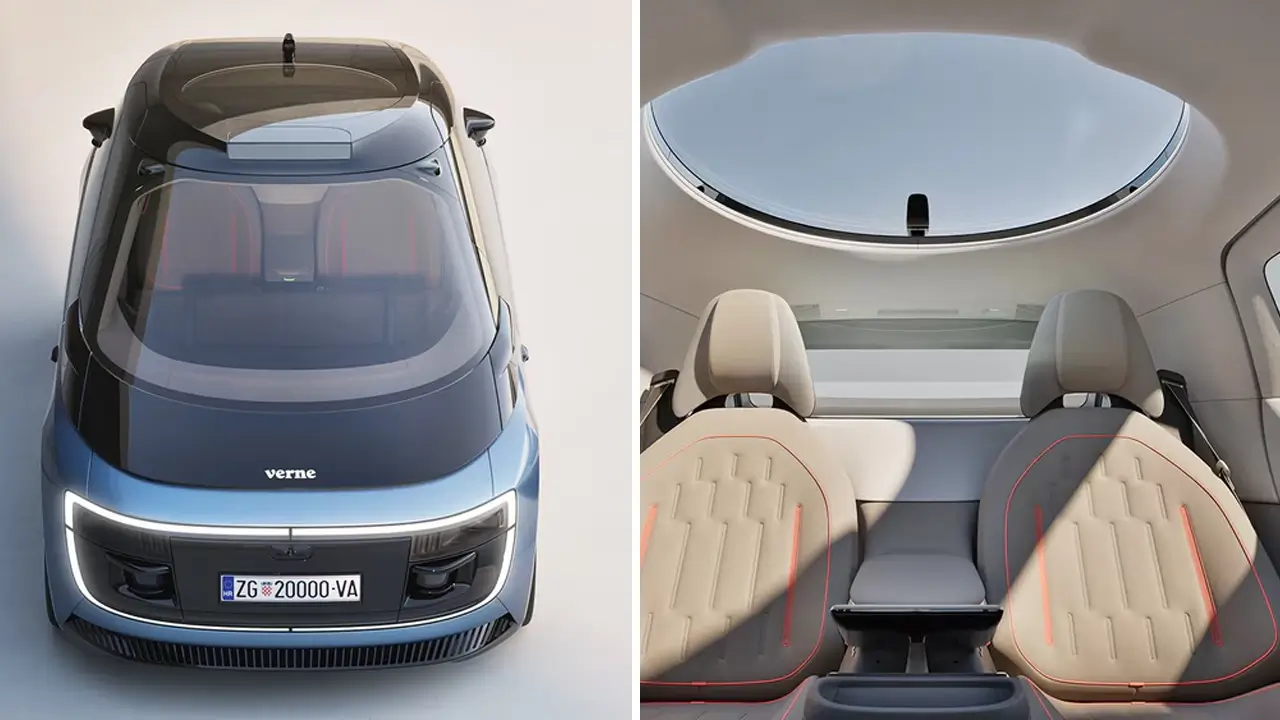In the spirit of Jules Verne, the visionary who dreamed up fantastical futures that often became reality, Mate Rimac, the founder of Rimac Automobili, is taking on his next seemingly impossible mission: revolutionizing urban mobility. The 2026 Rimac Verne, a stylish, fully autonomous electric ride-hailing vehicle, aims to offer the luxury and space of a limousine within the compact footprint of a subcompact SUV. This groundbreaking vehicle is set to redefine mobility as a service (MaaS), starting with its debut in Zagreb, Croatia, and expanding to cities in the UK, Germany, and the Middle East.
The Genesis of Project Verne
Originally known as Project 3 Mobility, this endeavor was co-founded by Mate Rimac and Marko Pejković in 2019. The project has attracted significant investment from the Saudi sovereign wealth fund, Kia, and the European Commission, among others. Verne stands apart from existing robotaxis like Waymo, Cruise, and Motional by integrating its sensors seamlessly into a design inspired by Jules Verne’s Nautilus submarine. This design not only enhances aesthetics but also ensures superior functionality and near-hemispheric visibility through its “Halo” sunroof.
The Mothership Concept
Before Verne can commence its service in any city, a central hub, referred to as the “Mothership,” is established. This facility is crucial for the daily inspection, maintenance, cleaning, and charging of each mobility pod. Initially, charging will be facilitated via CCS plugs at 100 kW, with future plans to incorporate NACS ports for a more streamlined robotic connection.
User Experience
The Verne experience is managed through a smartphone app, which not only allows users to hail and monitor their rides but also customize their in-cabin environment. Riders can adjust comfort settings, ambient lighting, temperature, and even select from four scents—Pine, Mango, Mint, and Ocean—ensuring a personalized and luxurious experience every time. This level of customization distinguishes Verne from traditional ride-hailing services like Uber, making each ride feel uniquely tailored to the user.
The Two-Seat Hatchback Revolution
The Verne’s design, crafted by Adriano Mudri—who also designed the Rimac Nevera—focuses on optimizing space and comfort. Despite its compact size, the Verne offers the seating and ambiance of a Rolls-Royce. The two-seater hatchback is designed based on data indicating that nine out of ten rides are used by one or two people. Its dimensions are comparable to a Jaguar E-Pace but with significantly more interior space.
Inverse Minivan Doors and Luxurious Seating
One of the standout features of the Verne is its sliding doors, which open wide while extending less than a foot from the body, facilitating easy ingress and egress. The seats, positioned two feet off the ground, offer multiple configurations, including fully reclined Oasis mode and Cinema mode, complete with footrests and a center console. The console houses a tablet to control a 43-inch cross-car video screen and a 17-speaker audio system. The windshield and other windows are made from acoustic laminated and electrochromic glass, providing both noise reduction and privacy.
Safety and Autonomy
Occupant safety is a top priority for Verne. The absence of a traditional dashboard or steering wheel reduces the risk of injury in a frontal collision. Knee airbags and shoulder belts are designed to minimize forward movement and bruising. Mobileye, an Israeli expert in autonomous technology, provides the suite of sensors required for full autonomy. These include vision cameras, imaging radar units, and lidar units. In case of extreme weather or sensor failure, the vehicle can execute a “minimum risk maneuver” to safely park itself.
Chassis and Powertrain
The Verne utilizes a skateboard chassis construction, featuring a 60 kWh battery pack, a 208-hp permanent-magnet motor, and the main components of the HVAC system. Weighing approximately 4,650 pounds, the Verne offers a balance of power and efficiency similar to a single-motor VW ID4. The battery is designed to last 14 to 17 hours in urban conditions and can be recharged in 30 minutes.
- Audi GT50 Concept: A Loud Reminder of Why Car Enthusiasts Fell in Love With Audi
- Nearly 30% of UK Drivers Believe Car Tax Should Be Based on Mileage — Survey
- Why Planes and Boats Escaped the Luxury Tax But Cars Didn’t
- Australia’s Headlight Confusion: Authorities Warn Drivers After Viral $250 Headlight Rule Goes Wild Online
- 2025 Hyundai Venue Facelift Launched in India – Full Details, Variants, and Price
Why Cities Should Embrace Verne
The Verne aims to complement existing public transportation systems, offering convenient and affordable last-mile solutions. By reducing the need for second or third-household cars, Verne helps to alleviate traffic congestion and free up parking spaces. Initially, Verne will serve airport transfers and trips within the southeast quadrant of Zagreb with a fleet of 40 vehicles, with plans to scale up to 400 to 450 cars as the service expands.
Conclusion
The 2026 Rimac Verne is set to revolutionize urban transportation by offering a luxurious, fully autonomous ride-hailing experience. With its innovative design, advanced safety features, and commitment to sustainability, the Verne represents a significant leap forward in the future of mobility. As cities around the world seek to reduce traffic and improve transportation efficiency, the Verne offers a compelling solution that blends luxury, convenience, and cutting-edge technology.
Source and Image Credit

